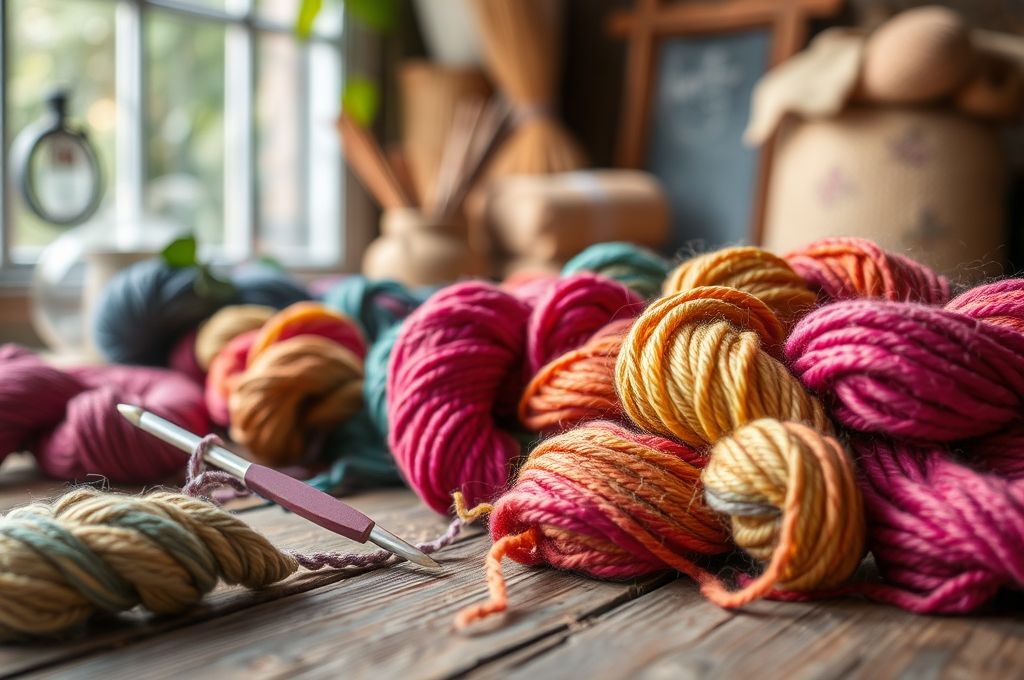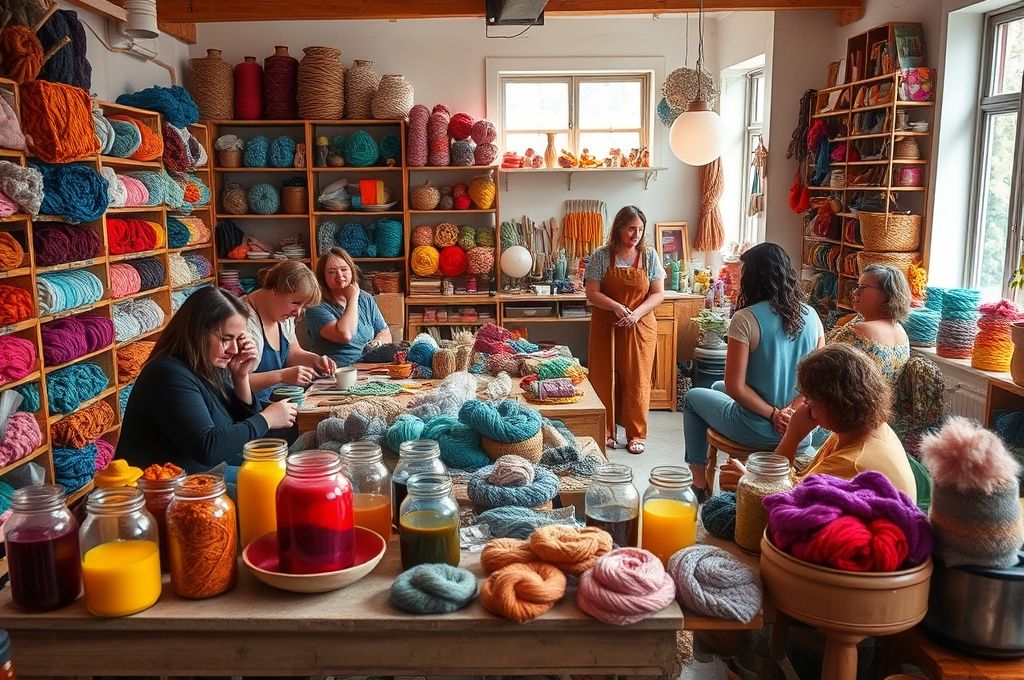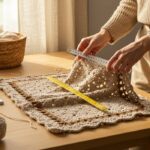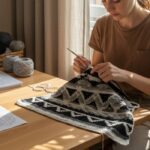The Art Behind Every Stitch
Imagine picking up a skein of yarn that looks like a sunset captured in wool—swirls of coral, gold, and deep violet blending together in a way no factory could replicate. This isn’t mass-produced; it’s hand-dyed by an indie yarn dyer pouring passion into every batch. In recent years, the world of fiber arts has seen a quiet revolution—one dyed skein at a time. Independent yarn dyers, often working from home studios or small workshops, are redefining what knitting and crochet materials can be: vibrant, personal, and full of soul.
Unlike commercial yarns that prioritize consistency and scale, indie dyers celebrate uniqueness. Each skein tells a story—of color inspiration, of technique, of a maker who cares deeply about their craft. Whether you’re a seasoned knitter or just discovering the joy of working with your hands, exploring hand-dyed yarns opens a door to creativity you might not have known existed.
In this article, we’ll dive into the colorful world of indie yarn dyers. We’ll explore what makes their work special, how they create such stunning effects, where to find them, and why supporting these artisans benefits both crafters and communities. Along the way, you’ll discover practical tips for choosing, using, and caring for hand-dyed yarns—and maybe even feel inspired to try dyeing your own. Let’s unravel the beauty behind these one-of-a-kind creations.
What Makes Indie Yarn Dyers Different?

When you walk into a big craft store, the yarn aisle is neatly organized: rows of identical skeins, labeled by weight and fiber content. Everything is predictable. That’s great if you want consistency—but sometimes, what we really crave is surprise.
Indie yarn dyers thrive on unpredictability. These are typically small-scale artists who dye yarn in small batches, often by hand, using techniques that result in subtle (or dramatic) variations between skeins. No two skeins are exactly alike—and that’s the point. Many indie dyers run their businesses solo or with a small team, handling everything from dyeing and packaging to customer service and social media.
But it’s not just about looks. Indie dyers often prioritize ethical sourcing, sustainability, and transparency. They’re more likely to use eco-friendly dyes, source wool from humane farms, and offer detailed information about where their fibers come from. Some even name their colorways after books, music, or personal memories—adding emotional depth to the product.
For example, Solstice Fiber Arts in Oregon names its colors after celestial events, while Fyberspates in the UK draws inspiration from British gardens and architecture. This personal touch transforms yarn from a mere material into a piece of art.
Moreover, indie dyers are highly responsive to their communities. They listen to feedback, create limited-edition colorways for holidays or events, and often collaborate with designers to produce exclusive kits. This close relationship between maker and maker (yes, both the dyer and the knitter are makers!) fosters a sense of connection that’s rare in today’s fast-paced consumer culture.
So when you buy from an indie dyer, you’re not just getting beautiful yarn—you’re supporting a person, a vision, and a slower, more thoughtful way of creating.
The Magic of Hand-Dyeing: How Colors Come to Life
Ever wonder how that mesmerizing gradient or speckled pattern ends up on a skein of yarn? The process is equal parts science and artistry. While methods vary, most indie dyers use acid dyes and heat to bond color to protein fibers like wool, alpaca, or silk. But the real magic happens in how they apply those dyes.
One popular technique is low-water immersion dyeing, where yarn is loosely bundled and partially submerged in dye baths. This creates soft, organic blends and “blooms” of color that shift as you knit. Another favorite is spray dyeing, where vibrant colors are misted onto the yarn, resulting in bold, painterly effects. For speckled yarns, dyers often flick or sprinkle dye by hand—like Jackson Pollock with a dropper bottle.
Take MadelineTosh, one of the most well-known indie brands. Founder Toshiko Minami starts with a vision—say, a New Mexico sunset—and experiments with dye combinations until she captures that exact mood. Each batch is carefully documented so she can recreate the color, yet slight variations always remain, making each skein unique.
Then there’s ombre or gradient dyeing, where a single skein transitions from light to dark or one hue to another. These are perfect for shawls or socks where you want a dramatic color shift without changing yarns. Some dyers even create “fractal” or “self-striping” patterns that produce intricate designs as you knit.
And let’s not forget natural dyes. A growing number of indie dyers are returning to plant-based colors—using avocado pits for blush pinks, onion skins for golds, and indigo for deep blues. Though more time-consuming and less predictable than synthetic dyes, natural dyes connect us to ancient traditions and reduce environmental impact.
The beauty of hand-dyeing lies in its imperfection. A slight splotch or uneven fade isn’t a flaw—it’s a signature. It reminds you that a human hand touched this yarn, that time and care went into every step. And when you knit with it, you’re not just making something; you’re continuing a story.
Where to Find Indie Yarn Dyers (And How to Support Them)

So, how do you find these creative artisans? The good news is, they’re more accessible than ever—thanks to the internet and a thriving handmade community.
Etsy is a goldmine for indie yarn. With filters for fiber type, weight, and color, you can easily search for “hand-dyed merino” or “speckled sock yarn.” But don’t just go for the first result. Read shop reviews, check photos for true color representation, and look for dyers who share behind-the-scenes content. A shop that posts dye-day videos or studio updates is likely passionate and transparent.
Craft fairs and fiber festivals are another fantastic way to discover new dyers. Events like Rhinebeck (New York), Knit City (Vancouver), or Yarnover (Texas) bring together hundreds of indie vendors. There’s nothing like feeling the yarn in person, seeing the colors under natural light, and chatting with the dyer about their process.
Many indie dyers also sell through their own websites, often offering subscription clubs or pre-orders for limited runs. Joining a yarn club—where you receive a surprise skein each month—can be a fun way to explore new dyers and color palettes. Some even offer “mystery” drops or seasonal collections that sell out in minutes, creating a sense of excitement and exclusivity.
But here’s the key: support them thoughtfully. Because indie dyers work in small batches, popular colorways may sell out fast. If you see something you love, don’t wait. Also, remember that shipping handmade goods takes time. Be patient and kind in your communications—these are often solo entrepreneurs juggling dye pots, emails, and family life.
And when you do buy, leave a review. Share your project on Instagram and tag the dyer. Word-of-mouth is everything in the indie world. A simple “I love this yarn!” can make someone’s day—and help others discover their work.
By choosing indie, you’re voting for creativity, sustainability, and individuality over mass production. You’re saying yes to color, craft, and connection.
Choosing the Right Hand-Dyed Yarn for Your Project
Now that you’ve found a gorgeous skein, how do you use it? Hand-dyed yarns are special, and a little planning goes a long way in making your project shine.
First, consider the color pattern. Variegated yarns—those with multiple colors—can be stunning, but they don’t work for every stitch. Busy cables or lace patterns might get lost in a highly variegated yarn. On the other hand, a simple stockinette or garter stitch can become mesmerizing when paired with a gradient or speckled yarn.
For example, a self-striping sock yarn works beautifully for basic socks, creating automatic color changes with each round. But if you’re making a complex lace shawl, a more tonal or semi-solid hand-dyed yarn might let the pattern stand out.
Next, check the dye lot. With indie yarns, each batch is a “dye lot”—and even if two skeins look the same online, they might vary slightly in real life. If your project requires multiple skeins (like a sweater), try to buy them from the same batch. Some dyers label their skeins with lot numbers; others recommend alternating skeins every few rows to blend any differences.
Also, pay attention to fiber content. Superwash merino is great for socks because it’s durable and machine-washable. Silk blends add shine and drape, perfect for shawls. But if you’re making a baby blanket, you might want something softer and hypoallergenic, like alpaca or organic cotton.
And don’t forget yardage. Indie skeins often have less yardage than commercial ones, so always double-check your pattern requirements. Running out mid-project can be frustrating—especially if the colorway is sold out.
Finally, trust your instincts. If a color speaks to you, go for it. One of the joys of hand-dyed yarn is wearing something truly unique. Even if it’s not “perfect,” it’s yours—dyed by hand, chosen with care, and made with love.
Caring for Hand-Dyed Yarn: Tips to Preserve Color and Quality
You’ve invested in a beautiful skein—now how do you keep it looking its best?
The first rule: always hand-wash. Even if the label says “machine washable,” hand-dyed yarns benefit from gentle care. Use cool water and a mild detergent like Eucalan or Soak. Avoid harsh soaps or bleach, which can strip color and damage fibers.
When washing, never agitate or wring the fabric. Swish it gently, then press out excess water. Rolling your project in a towel helps remove moisture without stretching. Always lay flat to dry—hanging can cause garments to stretch out of shape.
Another important tip: do a bleed test. Especially with deeply saturated or red/black yarns, colors can run on the first wash. To test, soak a swatch in cold water for 10 minutes. If the water turns colored, wash the finished item separately or use a color-catcher sheet.
Also, store your yarn properly. Keep it in a cool, dry place away from direct sunlight, which can fade colors over time. Moths love wool, so consider using cedar blocks or lavender sachets instead of chemical repellents.
And what about pilling? All yarns pill to some degree, but hand-dyed ones may show it more due to the texture of the fibers. Use a fabric shaver gently if needed, but remember: a little wear is a sign of love and use.
With proper care, your hand-dyed projects can last for years—growing softer, more personal, and full of memories. Each time you wear that shawl or wrap that scarf, you’ll remember the care that went into making and maintaining it.
The Ripple Effect: Why Supporting Indie Dyers Matters
Buying hand-dyed yarn isn’t just about aesthetics—it’s a small act of resistance against fast fashion and mass production.
When you support an indie dyer, you’re supporting a real person—often a woman, a parent, or someone building a creative career on their own terms. Many indie dyers started as hobbyists who turned their passion into livelihoods. Your purchase helps them pay rent, buy supplies, and maybe even hire an assistant.
But the impact goes beyond economics. Indie dyers often source ethically. They partner with farms that treat animals humanely, use biodegradable packaging, and minimize water waste. Some donate a portion of profits to environmental or social causes. By choosing them, you’re voting for a more sustainable, compassionate textile industry.
There’s also a cultural value. Hand-dyeing is part of a broader revival of craft and slow living. In a world of instant gratification, taking time to create something beautiful—whether as a dyer or a knitter—reconnects us to our hands, our history, and each other.
And let’s not underestimate the joy factor. Have you ever seen someone unwrap a surprise yarn club package and gasp at the colors? Or watched a knitter’s face light up when they see how the yarn shifts in the light? These moments matter. They bring delight in a world that often feels too serious.
So yes, indie yarn may cost more than store-bought. But you’re not just paying for fiber—you’re investing in artistry, ethics, and emotion. And that’s a price worth paying.
How to Start Dyeing Your Own Yarn (Even as a Beginner)
Feeling inspired? Why not try dyeing your own yarn?
You don’t need a lab or expensive equipment. With a few basic supplies, you can create custom colors in your kitchen.
Here’s what you’ll need:
- White or light-colored wool yarn (superwash works best for beginners)
- Acid dyes (available in kits online)
- White vinegar
- Squeeze bottles or spray bottles
- Gloves and apron
- Stainless steel pot
- Plastic wrap or zip-top bags
Simple method: Microwave dyeing
- Soak yarn in a vinegar-water bath (1 part vinegar to 4 parts water) for 20 minutes.
- Wring out excess liquid.
- Place yarn in a zip-top bag or on a tray.
- Squeeze different dye colors onto the yarn in patterns you like.
- Cover with plastic wrap or seal the bag.
- Microwave in 30-second bursts until steam rises (usually 1–2 minutes).
- Let cool, rinse in warm water, then wash gently.
That’s it! You’ll have a one-of-a-kind skein ready for your next project.
Dyeing your own yarn is incredibly satisfying. You control the colors, the intensity, the placement. It’s meditative, creative, and a little magical. Plus, it deepens your appreciation for what indie dyers do every day.
Even if you never sell your creations, dyeing at home connects you to the full cycle of making—from fiber to finished object. And who knows? You might discover a hidden talent.
Final Thoughts: More Than Just Yarn
Hand-dyed yarn from indie dyers is more than a crafting supply. It’s a celebration of individuality, craftsmanship, and mindful creation. Each skein carries intention, emotion, and a story waiting to be knit into something new.
In a world that often feels automated and impersonal, these small acts of handmade beauty remind us of what matters: slowing down, creating with care, and supporting one another.
Whether you’re buying your first indie skein, trying a new dye technique, or simply admiring the colors on your shelf, you’re part of a vibrant, growing community. One that values color, connection, and the quiet joy of making.
So next time you pick up your needles or hooks, take a moment to appreciate the journey of your yarn—from the farm to the dyepot to your hands. And remember: every stitch you make is a continuation of that story.
Share Your Yarn Love
Have you tried hand-dyed yarn from an indie dyer? What was your favorite colorway or brand? Share your experience in the comments below—or tag us on social media with a photo of your latest project. Let’s celebrate the artists, the colors, and the craft that brings us together.
And if you’ve never tried indie yarn? Start small. Buy one skein. Make a pair of socks, a cowl, or a simple dishcloth. See how it feels to work with something truly unique.
Because in the end, it’s not just about what you make. It’s about how it makes you feel.

Daniele Ferreira is passionate about the world of crochet, dedicating her time to exploring techniques, creating unique pieces, and sharing her knowledge with beginners and aficionados alike. With attention to detail and creativity, she transforms yarn into true works of art, inspiring others to discover the beauty and joy of this manual art.







